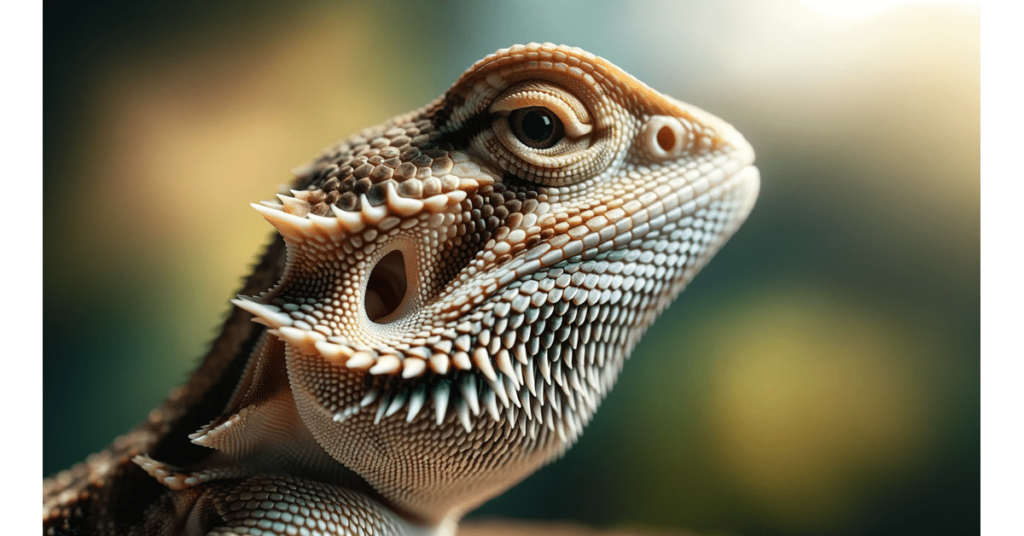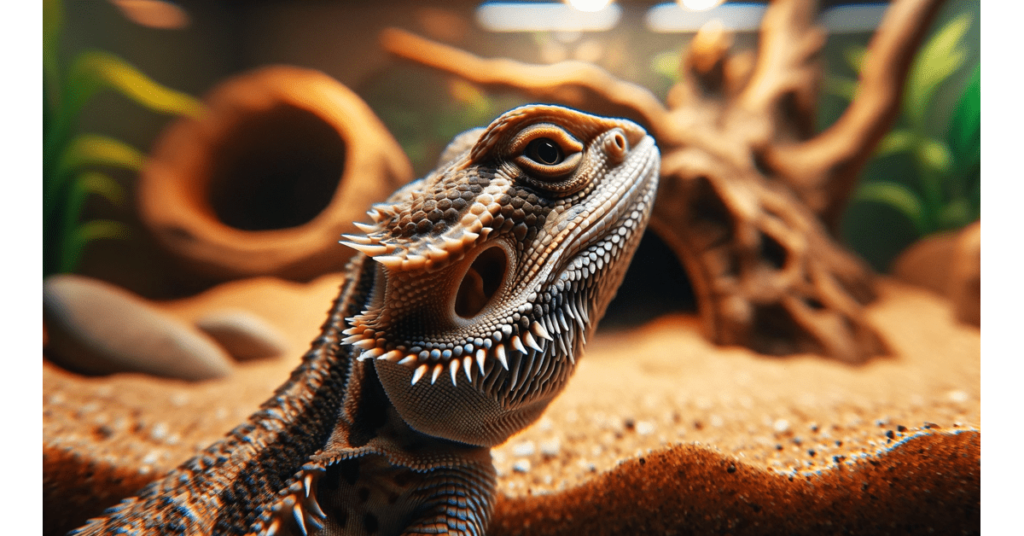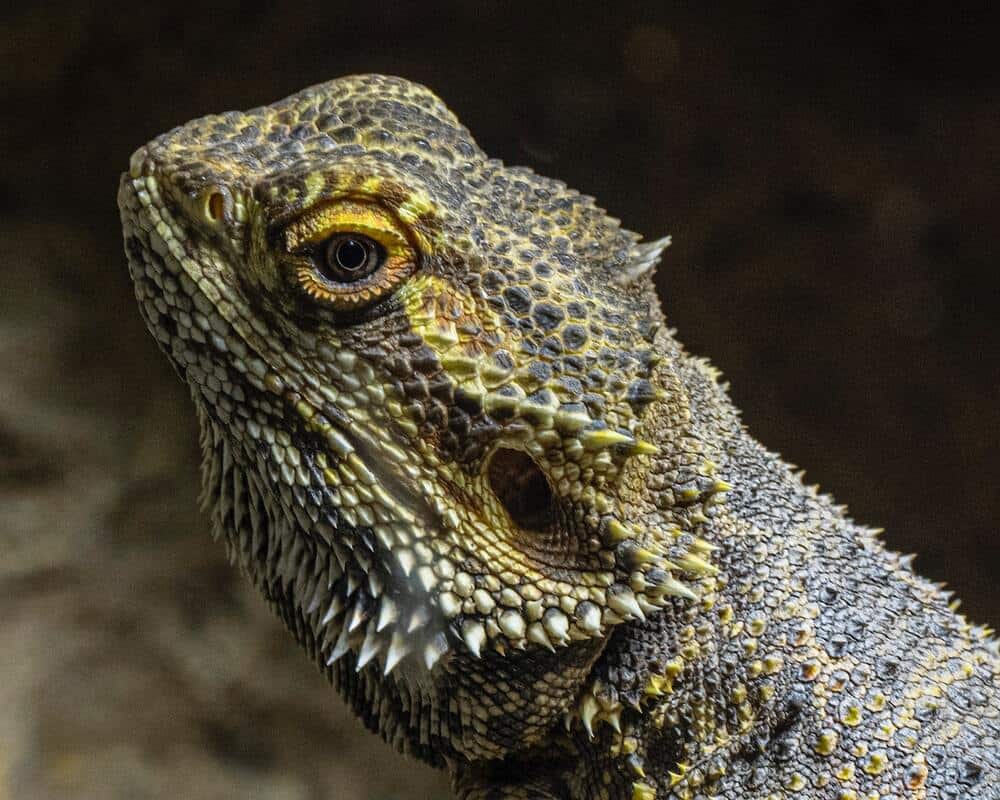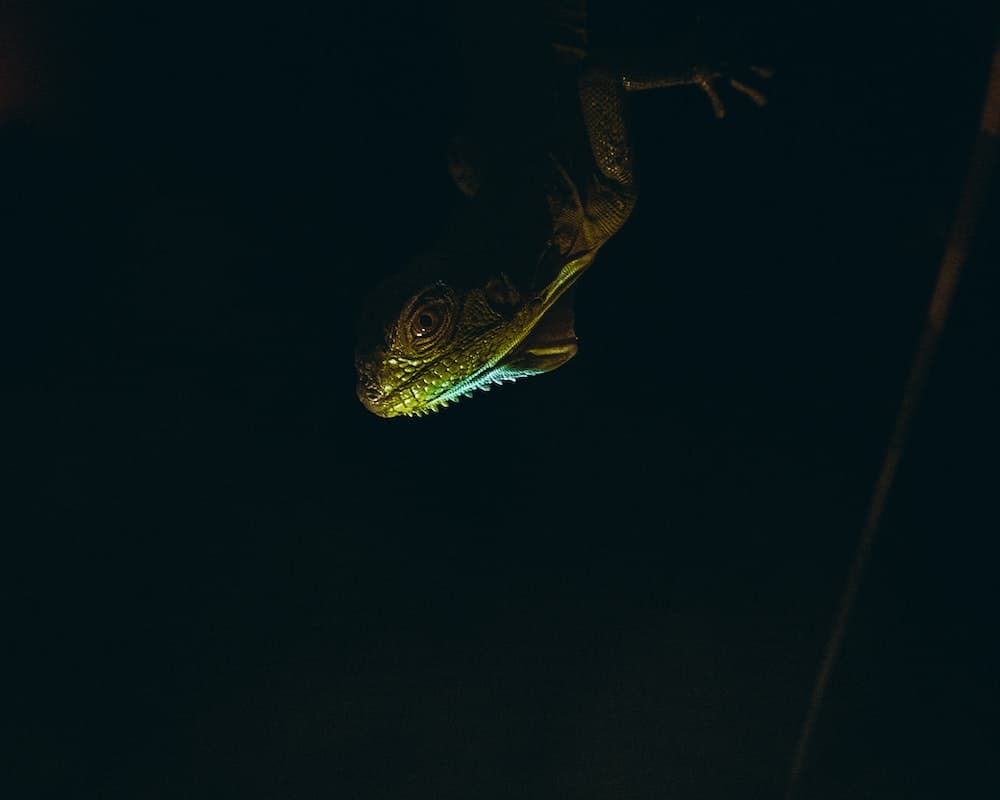Bearded Dragon Ear infections are a common health concern. Usually caused by bacteria or fungus, some common symptoms are head shaking or tilting, lethargy, swelling around the ear, and loss of hearing. Ear infections are curable with timely attention and care.
How to Locate Their Ears?
The ears are plain round holes. Present on either side of the head, and the ears are in the same line as that of each eye. You can easily locate them halfway between the eye and mouth.
Unlike mammals, the ears are just simple holes without any external lobes. They lack any external sound-collecting appendages or earlobes.
However, just like mammals, they have an internal structure divided into the middle ear and the inner ear. The ears have a fine membrane called the tympanic membrane which is slightly sunken and covers the middle ear.
In a healthy beardie, this tympanic membrane is visible from above. This membrane should not be touched or punctured.
It is important to note that an infection does not necessarily mean the symptoms will be around the ear alone.
A typical healthy beardie should be:
- Alert and active
- Has no swellings
- Has the ability to balance itself well
- The tympanic membrane is clean and without spots
Does My Bearded Dragon Have an Ear Infection?
There are a few ways to know when your beardie has an infection. It is difficult to diagnose at an early stage.
However, with the following visible symptoms, you can diagnose an ear infection that has advanced a little.
- Tilting of the head
- Loss of balance or disorientation
- Swollen tympanic membrane
- Discharge
- Black or brown spots on the membrane
- Loss of hearing
- Lethargy

9 Causes of Ear Infections in Bearded Dragons
It is extremely common for them to get ear infections due to the structural nature of their ears. The open and inverted structure of the ear makes it susceptible to bacterial and fungal infections.
There are some external factors that can cause these infections.
- High Humidity in the Pet Tank
The presence of high humidity levels in the tank can raise the chances of an infection. Since the tanks are enclosed spaces, high humidity levels are a common phenomenon.
Excessive humidity also prevents proper shedding of beardies, because of which some shed might clog their ears and cause infections.
- Lower Temperatures in the Pet Tank
Beardies are used to warm and dry climatic conditions. Since pet tanks are prone to get colder, the growth of infections becomes easier.
- Unclean and Unhygienic Tank
An unclean tank can spread the growth of various bacteria. Since the tanks are enclosed, the unhygienic conditions can boost the growth of certain bacteria.
- Absence of UV Light in the Pet Tank
Beardies thrive best in climates with a lot of sun exposure. Therefore they are used to getting good UV rays exposure.
The absence of sufficient UV ray exposure can reduce their immunity and can make them susceptible to getting infections, of which ear infection is one.
- Poor Diet
A bad-quality diet also reduces immunity. A weaker immunity means it cannot fight off bacterial attacks and become more prone to infections.
- Foreign Object Lodged in the Ear Aperture
Sometimes, it is just an external tiny object that may get lodged in the open hole that is the ear of the bearded dragon. Any external object can cause infections.
- Improper Shedding
Beardies shed their ears too. It is very common for bearded dragons to go through improper shedding.
Mostly, when the humidity levels are not maintained, the shedding goes wrong, and the skin might get stuck, causing discomfort and thus causing infection.
- Eating or Drinking near a Bearded Dragon
If you have a habit of eating or drinking in the vicinity of your pet, then your pet is exposed to more bacteria. In such cases, they can likely catch any infection.
- Infrequent Visits to the Vet
Not taking your beardie for a vet check-up means letting certain infections go undiagnosed. If the infections are detected earlier, a lot of damage can be curbed.
Best 8 Preventive Measures to Protect Bearded Dragon’s Ears
Prevention is better than cure, goes the old proverb. So, let’s discuss some of the preventive measures that you can take to protect your pet from getting infections.
- Cleaning the Pet Tank Regularly
It is essential to clean your pet tank regularly. It will help the tank to remain fungi-free and germ-free. If possible, you should clean it on a monthly basis.
If you’re unsure about how to clean the tank properly, you can check out this video.
Along with this, it is also advisable to clean the water dish, the feeding plate, and other equipment in the tank. All this will ensure a clean and habitable surrounding.
Important tip: Ensure you have a backup place to put your pet while cleaning the tank. The backup place should also be equally clean.
- Maintain the Humidity Levels in the Pet Tank
The optimum humidity levels in the pet tank should be somewhere between twenty to forty percent of the current humidity levels.
Since humidity levels may vary according to changes in the weather, it is best to invest in a digital hygroscope.
Also, demisting the pet tank glass and not keeping the water bowl inside the tank will greatly help reduce the humidity.
- Monitor the Temperature in the Pet Tank
Buying a thermometer is another wise preventive investment. Regularly monitoring the tank temperature and taking measures to provide optimal warmth to your pet can prevent ear infections for your pet.
Usually, the tank needs to be maintained at a temperature between 75ºF and 85ºF.
- Regular Visits to a Veterinary Doctor
Ensuring regular visits to a veterinary doctor will help you detect certain infections in the early stages and curb them accordingly. A visit to a vet is also helpful as you learn many ways to care for your pet, which involves certain dos and dont’s.
- Cleaning a Healthy Bearded Dragon
It is essential to clean your beardie regularly. Giving them a clean bath ensures that they shed properly.
Usually, bathing them once a week should suffice. Ensure that the water temperature is set between 85ºF to 100ºF.
Important tip: Never add chlorine or cleaning agents to the water tub. Your beardie may drink this water in addition to causing damage to his skin.
You can check out this awesome video about cleaning your beardie.
- Providing a Good Diet
A good diet consisting of fresh green leafy vegetables, other vegetables, limited choices of fruits, and insects that are gut-loaded with Calcium and Vitamin D3 will ensure a healthy diet.
- Using a UV Light
Installing a good quality UV light in the tank will ensure that your beardie gets sufficient Vitamin D to help boost its immunity, thereby preventing any infections.
- Personal Hygiene for the Owner
Ensure that you maintain your personal hygiene by frequently washing your hands whenever you handle your pet. Also, ensure that you do not eat or drink near your pet as it spreads the growth of bacteria.
Treatment Options for Bearded Dragon Ear Infection Symptoms
The only thing that you should be doing in case there is an ear infection is to take your beardie to a veterinary doctor.
A vet will either prescribe antibiotics or give them an antibiotic shot.
It is important to follow the vet’s instructions and treat the infection accordingly. Failing to do so might worsen your pet’s infection.

FAQs
Should I try to remove any object or partially shed skin stuck in the ear?
No! It is not advisable to clean out anything stuck inside a bearded dragon’s ear, as you may end up puncturing the fine membrane or hurting your pet further. Vets have special devices that can easily remove anything stuck inside your pet’s ear.
Is it necessary to clean a bearded dragon’s ears often to prevent infection?
It is not necessary to clean a bearded dragon’s ears explicitly. They shed their ear skin, too, which is a natural way for them to clean their ears. Letting them clean and not peeling or forcing the process is essential. The peeling may end up hurting them and inviting more bacterial infections.
If I have another pet, should I let them around the bearded dragon?
Though beardies can be friends with your other pet, it is advisable to exercise caution while letting them bond. Other pets, like dogs, can bring a host of parasites and bacteria.
Therefore, asking your vet for the best instructions according to the kind of pet you have, along with the beardie, is highly advisable.




